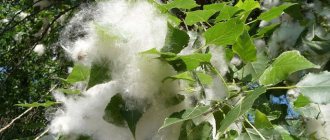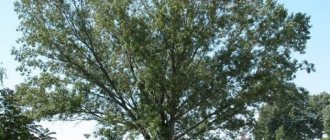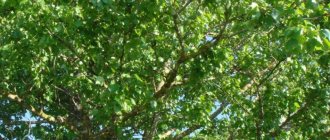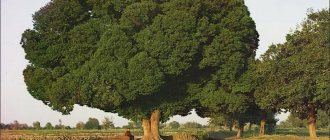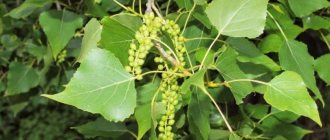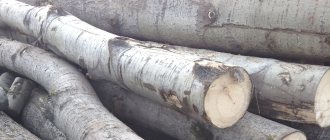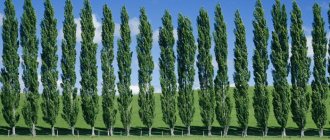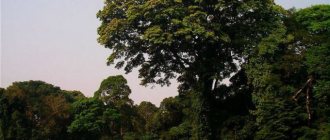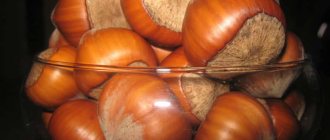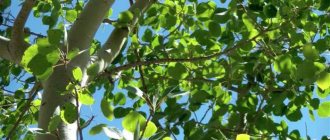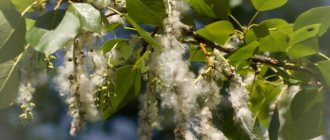Black poplar is a tall tree with a powerful crown; it belongs to the genus poplar (Populus) of the willow family (Salicaceae). A plant widespread in the CIS countries.
First of all, black poplar was used in folk medicine. Most often, leaf buds of the plant, rich in biologically active substances, are used for medicinal purposes. They are used for colds, diseases of the respiratory system, gastrointestinal tract, kidneys, bladder, female genital area, diseases of the joints, skin, burns, etc. Black poplar medicines are also recommended for hair loss.
Essential oil is obtained from the buds of black poplar (sedge), which is used in the perfume industry and soap making to flavor soap.
Black poplar is a fast-growing tree and quite winter-hardy. It is planted for afforestation of steppe areas, as a soil stabilizer for ravines, banks, etc.
The great benefit of black poplar is its high ability to purify the air. One tree releases the same amount of oxygen as 7 spruces, 4 pines or 3 lindens and releases 20-30 kg from the atmosphere during the growing season. dust or soot. Based on this, black poplar is planted along roads, on streets, in alley plantings, parks, gardens, near houses, etc.
The plant serves as a source of pollen, as well as a special sticky substance from which bees produce propolis, which is a valuable medicinal product.
Types and varieties
The poplar genus, in addition to the black poplar species, includes more than 95 species, which are divided into 6 groups (sections) and hybrid species:
- Mexican poplars (Abaso): Mexican poplar – Populus mexicana Ex DC. and etc.
- delta poplars (Aigeiros):
- delta poplar – Populus deltoides Bartram ex Marshall;
Populus fremontii Watson et al.
- Leucoid poplars (Leucoides):
- poplar – Populus heterophylla;
Populus wilsonii K.Schneid. and etc.
- Populus:
- silver poplar (white) – Populus alba;
- aspen (trembling poplar) – Populus tremula and others.
aspen poplar – Populus tremuloides;
- balsam poplars (Tacamahaca):
- balsam poplar – Populus balsamifera;
laurel poplar – Populus laurifolia and others.
- turanga (Turanga): Euphrates turanga – Populus euphratica Olivier;
- poplar (Turanga sisolifolia) – Populus pruinosa Schrenk and others.
- Berlin poplar – Populus xberolinensis Dippe – a hybrid of laurel poplar and black poplar;
Some of them, for example, common aspen, are used for medicinal purposes.
Black poplar belongs to the group of delta-shaped poplars.
Black poplar. Latin name : Populus nigra L.
Black poplar. Other names : osokor, osokor, sokora, sokorina, yasokor, etc.
Botanical description
Black poplar is a deciduous tree. Height: 15-25, up to 35-40 m. The root system of black poplar is powerful, highly branched, penetrates deeply into the soil and spreads across a large area. Consists of superficial, obliquely located, anchor, and also adventitious roots. It has a great ability to form stump shoots.
The trunk of black poplar is single or spread, straight, slightly oval. The crown is wide, ovoid, spreading. The branches are thick, especially the lower ones, spaced apart and directed to the sides.
In trees of middle age and older, the bark is light gray, thick towards the base (4-6 cm), with growths, covered with cracks, the color is dark gray, almost black. Diameter: 1-2 m.
Annual branches are bare, cylindrical, shiny. Color: yellowish-gray, coppice grayish-green.
Black poplar buds are large, appressed, multi-covered, bud scales are free. Ovoid, cone-shaped, shiny, covered with sticky resin. When blooming, they are sticky and fragrant. Color: brown. Length: 7-10, up to 15 mm.
The leaves of black poplar are alternate, simple, large, almost triangular, broadly ovate, narrowed at the top, blunt at the base. Dense, hard, bare, serrated. Color of the upper part: dark green, glossy, lower part – pale green. Length: 4-11 cm, width: 3-9 cm. They are located on long petioles flattened laterally.
The plant is dioecious. Black poplar flowers are small with stipules, unisexual, collected in inflorescences - long, cylindrical, hanging catkins. Female ones - consist of 30-40 flowers, length - 5-6 cm, after fertilization increases to 8-11 cm. Male earrings are purple-red, length - 6-9 cm.
The fruit of black poplar is a single-locular, double-leaf capsule. Length: 5-7 mm, thickness 3-5 mm. Contains 10-12 small seeds with a tuft of silky white hairs, which facilitates their transport by wind over long distances. Length of black poplar seeds: 2-2.5 mm.
Black poplar blooms before the leaves bloom, in April-May. Wind pollinated. The seeds ripen in May-June.
Method of propagation of black poplar: seeds, root suckers, stump shoots.
Growing black poplar
Black poplar reproduces using seeds, cuttings and root shoots . Under normal weather conditions, the tree takes root well and begins to grow actively. The planting area should be level, with a slight slope possible.
You should refrain from planting sedge in lowlands. Salty soil is also harmful to tree growth. Ideally, planting a tree should be done in loam, sandy loam and black soil of medium looseness. Pay careful attention to the location of the tree: branched roots lying close to the surface can damage the road surface and underground communications. It is also important to maintain a minimum distance from the walls of houses and fences.
Sedge is planted in early autumn or spring after the snow has thawed. The tree hole should measure 0.6 by 0.6 meters. When planting, do not forget to add organic fertilizers and water the seedling. As the tree grows, you need to feed it.
On average, sedge grows by 0.7-1 meters per year. It is necessary to annually prune damaged shoots and loosen the soil. During drought, poplar seedlings need to be actively watered. A tree uses approximately 20 liters of water per week.
Poplar propagation through seeds and shoots is quite easy. Cuttings give the first roots a month after planting. After this, they can be planted permanently. Poplar seeds germinate in 98% of cases. To grow them, you just need to plant them in a suitable type of soil and cover them with soil on top.
For lovers of plants and trees, we suggest that you read another article about the tree - Russian birch.
Habitat
Black poplar is common in Europe, North Africa, Asia Minor, Iran, and Western China. And also in the European part of the CIS, in Ukraine, Crimea, the Caucasus, Western and Eastern Siberia, Central Asia, Eastern Kazakhstan.
Where does black poplar grow? The plant can be found in deciduous forests, groves, along the banks of rivers, lakes, water meadows, and valleys. It grows both singly and in groups of several trees. Forms small groves.
The plant is widely cultivated in temperate regions.
What poplar or sedge looks like
Poplar reaches a height of 25 meters, has a wide spreading crown, dark gray cracking bark. The branches are horizontal, almost bare.
The cultivated variety of black poplar is pyramidal poplar. It reaches a height of more than 30 meters, the branches are directed upward, the crown becomes pyramidal, like a cypress.
The root system is well developed, the roots spread far and wide. Young branches have a yellowish bark; as they grow, it becomes ash-gray. Mature trees have dirty gray bark with large cracks.
The leaves are alternate, rhombic, with a sharp apex. The leaf blade is bare and smooth. The petioles are long. Young leaves are sticky.
Black poplar is a dioecious plant: on some trees only male flowers develop, on others only female ones. Men's earrings are from 6 to 10 cm, and women's are longer - up to 12 cm.
Collection and preparation
For medicinal purposes, leaf buds, black poplar leaves, and less often branches and bark are harvested.
The buds are collected in early spring, at the beginning of the black poplar flowering, in April, when they are swollen but have not yet blossomed. They cut it off with their hands. In order not to disturb the growth and development of the tree, collection is carried out only from the lower side shoots.
Initially, the raw materials are dried in the open air, in the shade, under a canopy or indoors with good air ventilation, spread in a thin layer of 1-2 cm, not forgetting to stir periodically. It is permissible to dry it in the sun.
An important condition is that the initial drying should be carried out in a cool, unheated room (place). Otherwise, the buds begin to bloom and loss of essential oil occurs.
Color of finished raw materials: greenish, brownish-yellow. Smell: peculiar, balsamic. Taste: bitter.
Black bark poplar is collected in early spring from cut trees or branches. Dry as usual.
Finished dried raw materials are stored in boxes or bags made of natural materials in a dry room with good air ventilation. Shelf life of black poplar: two years.
Healing properties of kidneys
Sedge buds have a healing effect, so they are used in medicine. They are added to ointments, tinctures and decoctions. Used in the treatment of burns, gout, as a hair rinse, as well as for hemorrhoids and rheumatism. In addition, folk remedies are used for genitourinary diseases, cystitis, kidney disease, and prostatitis. In addition, poplar is also useful for neurosis, hemorrhoids, and diarrhea. By the way, decoctions are not only drunk, but also used for inhalation.
Collect useful buds and bark to improve the health of the body, but do not forget about contraindications
To use the buds to create medicines, they need to be collected and dried. To do this, collect them from the tree by hand in early spring. Then spread it in a thin layer in a shady place and dry it at a temperature of +30...+35 °C.
Characteristics of buds ready for collection:
- solid, oblong-oval in shape with a shiny bare surface;
- length – 1.5–2 cm, diameter – 4–6 mm;
- color green or brown-yellow;
- the taste is bitter;
- specific balsamic smell;
- humidity up to 12%.
Medicines containing poplar parts can only be used after consulting a doctor. They are contraindicated for pregnant women and people suffering from gastrointestinal diseases.
Chemical composition
The beneficial and medicinal properties are determined by the components in the chemical composition of black poplar. The glycosides populin and salicin, flavonoids, malic and gallic acids, leukoanthocyanins, chalcones, essential (up to 0.7%) and fatty oils, carbohydrates, tannins, bitter resin, and gum were found in the kidneys. Vitamins include ascorbic acid.
Black poplar bark contains alkaloids, phenol glycosides, flavonoids, tannins, and higher hydrocarbons. The leaves contain isoprenoids, carotenoids, alkaloids, organic and phenolcarboxylic acids, phenol glycosides, lignins, and tannins.
When to prepare medicinal raw materials
Sticky, unopened poplar buds, from which the tops of the leaves have not yet appeared, are valuable medicinal raw materials. The buds should be collected during the period of sap flow, before they begin to open. Dry the raw materials immediately, at a temperature not exceeding 35 °C, laying them out on paper. The collected buds need to be turned over and shaken.
Collect poplar bark in early spring from cut down or felled trees. Dry the bark in a ventilated area or in a dryer (oven). When drying in an oven, the maximum temperature is 50 °C. The main criterion for the readiness of the bark is its fragility; when bent, the raw material should break. The shelf life of the bark is 4 years.
Medicinal and beneficial properties of black poplar
Black poplar is a medicinal plant that has the following properties:
- bactericidal,
- antimicrobial,
- antiviral,
- emollient,
- anti-inflammatory,
- painkiller,
- diaphoretic,
- antipyretic,
- expectorant
- antiulcer,
- soothing,
- diuretic,
- hemostatic,
- wound healing,
- astringent,
- antipruritic,
- blood purifier, etc.
An alcohol tincture of black poplar buds helps destroy staphylococcus.
Important! The information presented in the material is for informational purposes only. Before use, be sure to consult a specialist.
The use of black poplar in folk medicine
A large number of people, freely using plants to treat various diseases, believe that they are absolutely harmless. However, among medicinal plants there are potent, toxic and even poisonous ones. In addition, many people, especially older people, have several chronic diseases.
Therefore, in order for the treatment to be effective, when using it, one should take into account the beneficial and medicinal properties of black poplar and the contraindications that it has, and this can only be done by a doctor. Based on this, before you start taking black poplar preparations, consult a doctor, or better yet, a herbalist you trust. The information given below is for informational purposes only.
Respiratory diseases
Black poplar is widely used for the treatment of respiratory diseases. Considering the bactericidal, antimicrobial, antiviral, anti-inflammatory, antipyretic and other properties of the plant, internal use of black poplar preparations is recommended for colds, flu, sore throat, fever, cough, as well as bronchitis, bronchial asthma, pneumonia, pulmonary tuberculosis, etc. For intermittent fever, take both an alcohol tincture of the buds and a decoction of the bark.
Kidney fat extract is prescribed as an external remedy as an antipyretic.
Gastrointestinal diseases
Since the plant regulates the digestive process, the beneficial and medicinal properties of black poplar are used both for the prevention and treatment of certain diseases of the gastrointestinal tract.
An infusion/decoction of the kidneys is drunk for gastritis, ulcerative colitis, intestinal atony, flatulence, nausea, vomiting, bloody diarrhea, etc. Black poplar tincture is also used for diarrhea.
As an emollient, anti-inflammatory, analgesic, the decoction, as well as oil and ointment, are used externally to treat hemorrhoids, including bleeding. In addition, after a cleansing enema, microenemas are made from black poplar oil for cracks and prolapse of the rectum.
Kidney and bladder diseases
Black poplar is used to treat diseases of the kidneys, bladder and urinary tract. Given the diuretic and anti-inflammatory properties, plant preparations are taken for cystitis, painful urination, kidney stones, etc.
Oncological diseases
Black poplar has been used in complex therapy for oncology. For these purposes, kidney infusion and extract are taken orally.
Nervous system diseases
Black poplar recipes are effective for treating diseases of the nervous system. As a sedative, internal intake of infusions, tinctures, and kidney extracts helps with increased nervous excitability.
Baths with a decoction of black poplar (leaves), as well as rubbing, are useful for their sedative effect.
For women
The benefits of black poplar with healing buds for women's health are great. Preparations of the plant (decoction of buds, bark, infusion of leaves) are taken both internally and externally in the form of douches for the treatment of menstrual disorders, trichomonas colpitis, leucorrhoea, etc. For dysmenorrhea, kidney tincture and extract are prescribed internally.
It is effective to use poplar ointment externally for trichomonas colpitis and cracked nipples.
For men
Traditional medicine recommends internal administration of kidney infusion and black poplar extract for spermatorrhea.
Oral diseases
As an anti-inflammatory agent, black poplar is useful for inflammatory processes in the oral cavity and periodontal disease. Also, for these purposes, tampons soaked in oil are applied to painful areas.
For toothache, pads are made from the juice of fresh black poplar leaves.
Joint diseases
Black poplar is a medicine recognized for the treatment of certain joint diseases. Internal administration of bark decoction, bud infusion, tincture, extract as an anti-inflammatory and analgesic is carried out for gout, polyarthritis, rheumatism, radiculitis, sciatica, etc.
External treatment consists of using tinctures, oils, and ointments for rubbing.
Skin diseases
The beneficial and medicinal properties of black poplar buds are effective against various skin diseases, including difficult-to-treat ones such as fungal infections. As an emollient, anti-inflammatory, analgesic, lotions and infusion baths are used for rashes, including pustular rashes, dermatitis, furunculosis, inflammatory processes, and skin itching. For staphylococcal lesions, use tincture of the kidneys.
Poplar oil and ointment also give good results.
Wounds, cuts, burns
Black poplar is widely used in medicine, mainly in folk medicine for various injuries of the skin. Recipes with black poplar have shown themselves to be effective for treating wounds, cuts, ulcers, burns, including sunburn, bruises, etc.
For these purposes, an infusion of kidneys is used for rinsing and dressings, and oil and ointments are used for lubrication, including for dressings.
For beauty
A natural healer, black poplar is also good for beauty. As a means of stimulating hair growth, infusion of buds is used to rinse hair after hygienic washing with massaging the scalp. Ointments and oils are used for alopecia.
For the whole body
The beneficial and medicinal properties of black poplar are also applicable for improving and strengthening health. Internal course intake of plant preparations (infusion, tincture) normalizes metabolic processes in the body. Due to their high vitamin C content, they are recommended for vitamin deficiency.
Black poplar buds increase the body's protective functions against ultraviolet rays.
Application of black poplar parts
Floats for fishing nets and cork products are often made from the bark of black poplar. To do this, bark with cracks and crevices is cut from mature trees in pieces 15–40 cm long and 3–8 cm wide. After this, the upper gray layer and weeds are removed. When cut, it is rounded-triangular in shape, 2.5–5 cm thick, and light red in color.
The tree is used to obtain cheap wood. Since its bark is porous and soft, it is easy to cut. In addition, it is well impregnated with varnishes, paints and antiseptics. And it sticks well. Therefore, it is used in the turning, furniture and pulp and paper industries.
The bast is the edible part of the plant. In dried form, it is used in cooking as an additive to flour. And it is also beneficial for health, like all other products prepared from poplar parts. They not only benefit the body, but also help cure many diseases.
In addition to all these properties, black poplar is also used in landscape design. They are often used to landscape populated areas, because it has many advantages. For example, decorativeness, rapid growth and the ability to purify oxygen from various impurities. In addition, its crowns are very large and produce more oxygen than many other crops.
Dosage forms
Kidney infusion
2 tbsp. pour 200 ml of raw materials. boiling water Cover with a lid, insulate and leave for 4-6 hours. Strain, squeeze out the raw materials.
Take 15 ml. 3 times a day before meals.
Leaf infusion
1 tbsp. pour 200 ml of raw materials. boiling water Cover with a lid, wrap and leave for 1 hour. Strain, squeeze out the raw materials.
Take half a glass 3 times a day before meals.
Tincture
The tincture is prepared from fresh or dried buds.
Fresh buds
If the collected buds are wet, they should first be dried in the shade. Then the buds are lightly rolled with a glass bottle for better extraction, placed in a glass jar (preferably dark glass) and filled with high-quality vodka in a ratio of 1:5.
Close the container tightly with a lid and leave in a dark place at room temperature for two weeks, remembering to shake periodically. Strain, squeeze out the raw materials.
Tincture made from fresh buds is more effective and healthy.
Dried buds
The tincture is prepared in the same way as from fresh buds, but the raw material is poured with vodka in a ratio of 1:10.
How to use
Take bud tincture 15-20 drops per 100 ml. boiled water three times a day before meals.
Oil
The oil is prepared from fresh or dried buds. If the collected buds are wet, then they are slightly dried in the shade. The raw materials are placed in a glass container (preferably dark glass) and filled with unrefined sunflower oil (preferably olive oil). Cover the container tightly with a lid and leave in a dark place at room temperature for two weeks to a month, remembering to shake periodically. Strain, squeeze out the raw materials.
Store in a cool place.
Ointment
Chop fresh kidneys and mix with lard (preferably made from interior fat) in a 1:1 ratio (by volume). Place the container in a water bath and simmer for half an hour. After cooling to a comfortable temperature, strain the mixture using gauze folded in several layers.
Store the finished ointment in a glass jar (preferably dark glass) in a dark, cool place, for example, in the refrigerator. Shelf life up to two years.
Contraindications
In order for the treatment to be effective and the results to last, before starting it, you should definitely take into account the benefits of black poplar and the harm that it can cause if used incorrectly.
The buds of the plant contain components that can irritate the gastrointestinal tract, kidneys and bladder, so when taking them internally, be sure to follow the recommended dosage. If the dosage is exceeded, nausea may occur.
Although black poplar preparations are recommended for treatment
- stomach,
- intestines,
- kidney,
however, if you have acute or chronic diseases of these organs, it is better to consult your doctor first.
You should also avoid taking black poplar internally during pregnancy. Individual intolerance to both internal and external use of plant preparations is possible.
Sources:
D.S. Ivashin, Z.F. Katina. Medicinal plants of Ukraine.
Advice from the traditional healer Evdokia. Herbalist, illustrated reference book.
Do it yourself. Supplement to the magazine "Ogonyok", No. 1, 1998.
I.N. Putyrsky, V. Prokhorov. Universal encyclopedia of medicinal plants.
V.V. Reshetnyak. Herbalist.
A.P. Popov. Medicinal plants in folk medicine.
